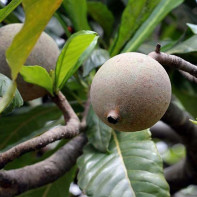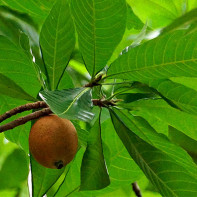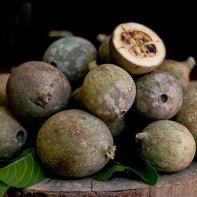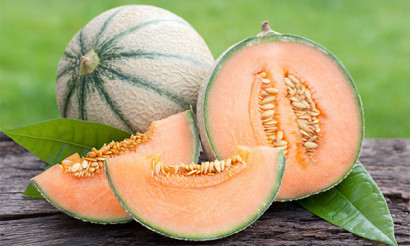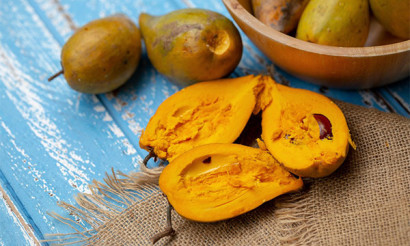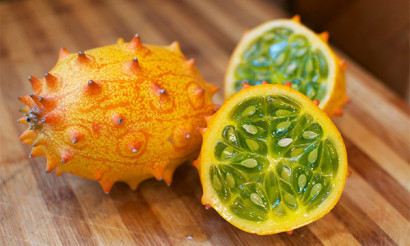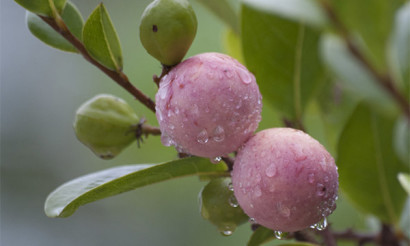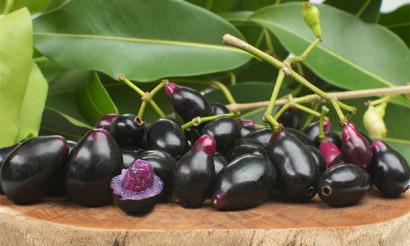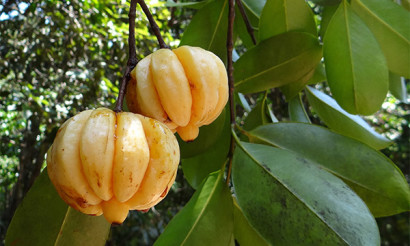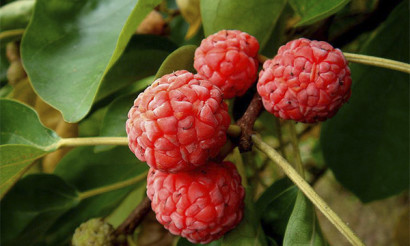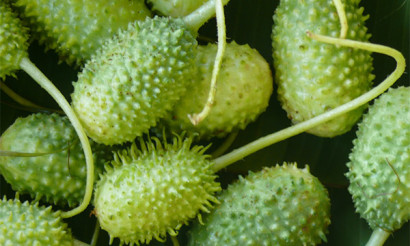Genipa: what kind of fruit is it and how is it healthy
The fruit tree of the madder genipa family reaches a height of up to 30. This slender tree, with sprawling branches, is interesting for its fruits, which the British nicknamed the “marmalade box”. Basically, because the skin is thick and dense, and the flesh is filled with aromatic sweetness.
Genipa is a deciduous plant. Glossy oval leaflets are edged at the edges with notches. The width of the leaves varies from 4 to 13 cm, and the length reaches 33 cm. A bright vein is clearly visible in the middle.
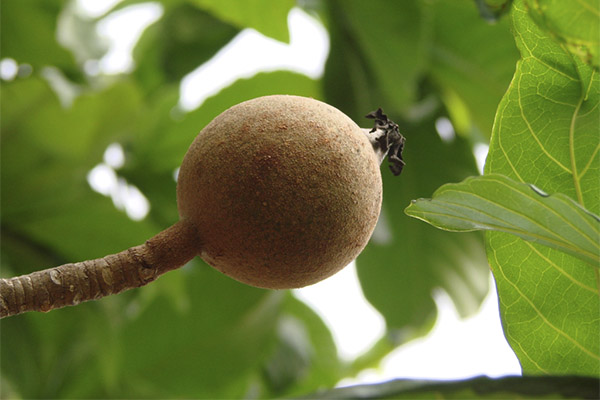
Inflorescences are large, 5–6 cm in diameter, rosaceous, have 5 petals of yellow, red or white hue.
The genipa fruits are oval in shape, 9-15 cm long, up to 9 cm wide. The skin is rough, as if slightly sprinkled with flour. Inside the fruit are light brown or yellow seeds. It is interesting that the inner flesh is initially cream-colored, but when it comes in contact with air, it gradually turns yellow. And these are not all the unique qualities of an overseas fetus.
Where grows
The wild-growing genipa occupied the territories of Cuba, Puerto Rico, the Virgin Islands, Guadeloupe, Trinidad - from southern Mexico, Colombia and Venezuela to Peru, Bolivia and Argentina. It is cultivated in the same area as a decorative and fruiting plant. For a long time grown genipa in the Philippines. In some countries, the tree is grown as a natural fence or hedge for pasture.
In the mid 60-ies of the last century, Latin America began a project to reproduce genipas for the restoration of forests in northeast Brazil. Extensive plantations were created there. Fruits went into the production of liquors and other food products, and wood was used for local needs.
In the Old World, the genipa is unknown. There have been attempts by Filipino enthusiasts to spread culture to the United States. The tree grew at a plant in Miami up to 6 m high, but it never bloomed. A large tree was also grown in the Manor agricultural research center in Russia. It did not bear fruit, and then it was killed by frost.
Taste test
This tree is grown for fruit. Ice cream, jelly, jam, jam, juices and jams are prepared from them. In natural form, fruits can only be eaten when they are overripe and soft. The taste, sour, resembles dried apples.
First you need to tear a little thin skin of the fruit and suck out the jelly-like contents from it. All seeds of the fetus and its peel are thrown out. If the seeds still got into the oral cavity, then they must be spit out.
Interesting detail: genipa juice is colorless. But in air, it comes into contact with human skin and turns into a resistant paint of a dark blue color, therefore it is used as a food coloring. The Indians draw on the body with this juice, and the color stays firm, up to three weeks.
No less exotic use was found by fishermen. They prepare bait from unripened fruits, and the inhabitants of the reservoirs willingly come down to dainty, falling for a bait.
In hot tropical countries, compotes from genips are relevant. Drink a thirst-quenching drink in pure form or added to wine. Another method used in Puerto Rico. The fruits are cut, put in water and wait for the start of fermentation. Only when the mush has fermented, add odorous fruits, berries, aromatic substances. In addition to quenching thirst, the infusion has a tonic property.
You can just chop the fruit, put it in a jug of water, add sugar, and you get a light drink for a hot day, reminiscent of lemonade.On the streets, merchants sell bottled ice concentrate. In the Philippines, soft drinks, as well as jelly, sorbet and ice cream, are in honor. Pulp sometimes serves as an additive as a substitute for pectin, which helps gelation of fruit juices. Brazilian villagers make fruit jam, syrup, soft drink, wine and strong liquor.
In fruits, studies show that there are proteins, carbohydrates, malic acid. Calories - 113 kcal / 100 g.
The healing qualities of genipa
Compote of genipa is not only pleasant to use and effectively quenches thirst. He has more valuable qualities.

- The inhabitants of Central America have long adapted to use compote as an expectorant for severe coughing. They also treat colds and tonsillitis. A decoction of flowers serves as an antipyretic, like leaf juice.
- The fruits are rich in calcium, phosphorus and ascorbic acid (vitamin C). Naturally, fruits have a general strengthening and rejuvenating effect on the human body.
- It is usual for the local population to resort to the fruits of the genipa in cases of jaundice and use it as an anthelmintic.
- The diuretic effect makes the fruit indispensable for edema of various etiologies, diseases of the urinary system.
- Traditional medicine recommends chopping unripe fruits and using it together with a decoction of bark in the treatment of pharyngitis and sexually transmitted diseases. In addition, the decoction of the root is also a powerful means of relaxation.
- Genipa bark is also useful. It is rich in tannin, which makes it indispensable in the treatment of infectious skin diseases. If an incision is made on a tree trunk, a light-colored resin flows from the bark, sweet in taste. So she is that very potent disinfectant. The resin is diluted with water and the resulting solution is washed not only with wounds and scratches, but even with sore eyes.
- An active antibacterial effect of genipa products on pathogenic microbes is also noted, that is, they act as an antibiotic. Ground seeds can be used as an emetic.
Contraindications
The experience of people cultivating the genipa, consuming its fruits, studying the properties of flowers, bark, leaves, roots suggests that there are no contraindications. Only individual intolerance is possible.
Where is genipa used
In Guyana, unripe fruits are mainly used as bait for fish. Wild and domestic animals eat fruits that have fallen to the ground. Foliage is a good livestock supplement.
The bark is often used in the treatment of the skin, is used to produce fiber. True, such threads are suitable only for rough clothing.
Young wood goes as firewood, fence posts. Ten-year-old trees are allowed on lumber. The wood is yellowish-white or even slightly pinkish, with barely noticeable streaks of reddish color. It has good fiber, hard, but elastic, strong. However, termites are very fond of this wood, which casts doubt on its strength.
Genipa makes many types of household utensils from wood, including carpentry. Flowers serve as a good honey plant for bees.
How to grow
Genip can be propagated by seeds and cuttings. Seeds do not even need to be specially prepared. It is enough to place a seed in well-loosened soil to a depth of half a centimeter. The place should be warm, above 23 degrees. The earth must be constantly moistened, but not wet.
Sprouts appear after 25-30 days. At the age of 6 to 12 months, they need to be transplanted. The tree is not demanding of attention, it survives and thrives well even in difficult situations.
If the priority is growing fruits, then the distance between the trees is 10-15 m. The falling leaves serve to enrich the plantation soil.
Culture grows right before our eyes. Three years later, we must wait for the first fruits. Most often, the tree bears fruit once a year.But there are especially productive varieties that delight their owners all year round. Genipa favors overmoistening and feels good on periodically flooded soils, but does not tolerate cold at all and does not survive a slight freezing, but dies.
Because this culture is not found in mountainous areas, where the weather is unstable and different from the hot and humid tropics.
Where to grow
The place must be chosen sunny, bright, if there is a shadow, then a little. Preferred reaction earth is neutral or slightly acidic. Watering should be plentiful, so that in the summer to keep the soil constantly moist - this is the case when it is better to overfill than underfill.
Top dressing should be carried out at least twice a month, alternating organic and mineral fertilizers. In winter, fertilizing is not required.
An important requirement for the regime is heat. In winter, the temperature is kept at 15–20 degrees, in summer - the hotter the better. Of course, the genipa can survive a short-term decrease in temperature to 0, but it is better not to risk it.
Interesting Facts
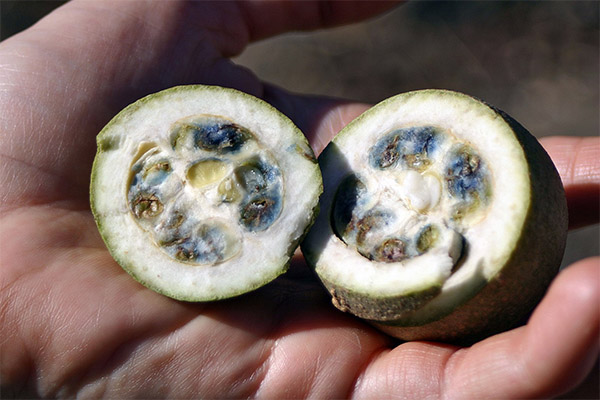
- In different countries, the genipa is called hagua, chibara, lana, vita, maluko.
- In the Peruvian reservoirs lives catfish parasite "candira". He literally paralyzes the local population with fear. It can swim in any, even the most intimate place of a person, and gain a foothold there with sharp spikes on the gills. The parasite feeds on blood and surrounding tissues, not only causes severe pain, but can be fatal. For extraction without surgical intervention can not do. Helps even the juice of the genipa fruit or burnt leaves. The introduction of these products to the place of attachment of the candiru kills the fish, and it can then be removed.
- Guatemalan Indians give the tree a sacred meaning. With certain rituals, they bear fruit in their hands, hoping and believing that this will save them from misfortunes and illnesses.
«Important: all information on the site is provided exclusively in fact-finding purposes. Before applying any recommendations, consult with a profile specialist. Neither the editors nor the authors are liable for any possible harm caused materials. "

